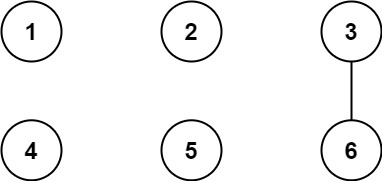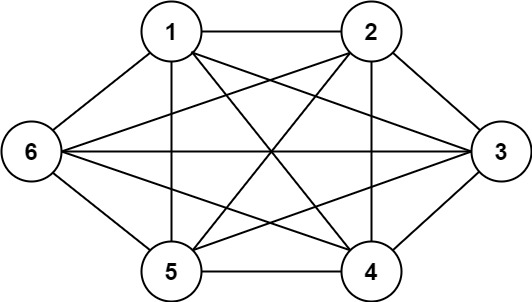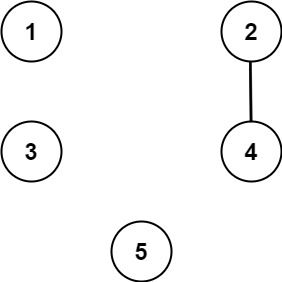1627. Graph Connectivity With Threshold
Description
We have n cities labeled from 1 to n. Two different cities with labels x and y are directly connected by a bidirectional road if and only if x and y share a common divisor strictly greater than some threshold. More formally, cities with labels x and y have a road between them if there exists an integer z such that all of the following are true:
x % z == 0,y % z == 0, andz > threshold.
Given the two integers, n and threshold, and an array of queries, you must determine for each queries[i] = [ai, bi] if cities ai and bi are connected directly or indirectly. (i.e. there is some path between them).
Return an array answer, where answer.length == queries.length and answer[i] is true if for the ith query, there is a path between ai and bi, or answer[i] is false if there is no path.
Example 1:

Input: n = 6, threshold = 2, queries = [[1,4],[2,5],[3,6]] Output: [false,false,true] Explanation: The divisors for each number: 1: 1 2: 1, 2 3: 1, 3 4: 1, 2, 4 5: 1, 5 6: 1, 2, 3, 6 Using the underlined divisors above the threshold, only cities 3 and 6 share a common divisor, so they are the only ones directly connected. The result of each query: [1,4] 1 is not connected to 4 [2,5] 2 is not connected to 5 [3,6] 3 is connected to 6 through path 3--6
Example 2:

Input: n = 6, threshold = 0, queries = [[4,5],[3,4],[3,2],[2,6],[1,3]] Output: [true,true,true,true,true] Explanation: The divisors for each number are the same as the previous example. However, since the threshold is 0, all divisors can be used. Since all numbers share 1 as a divisor, all cities are connected.
Example 3:

Input: n = 5, threshold = 1, queries = [[4,5],[4,5],[3,2],[2,3],[3,4]] Output: [false,false,false,false,false] Explanation: Only cities 2 and 4 share a common divisor 2 which is strictly greater than the threshold 1, so they are the only ones directly connected. Please notice that there can be multiple queries for the same pair of nodes [x, y], and that the query [x, y] is equivalent to the query [y, x].
Constraints:
2 <= n <= 1040 <= threshold <= n1 <= queries.length <= 105queries[i].length == 21 <= ai, bi <= citiesai != bi
Solutions
Solution: Union Find
- Time complexity: O(nlogn+queries.length)
- Space complexity: O(n)
JavaScript
/**
* @param {number} n
* @param {number} threshold
* @param {number[][]} queries
* @return {boolean[]}
*/
const areConnected = function (n, threshold, queries) {
const graph = new UnionFind(n + 1);
for (let factor = threshold + 1; factor <= n; factor++) {
for (let value = factor * 2; value <= n; value += factor) {
graph.union(factor, value);
}
}
return queries.map(([a, b]) => graph.find(a) === graph.find(b));
};
class UnionFind {
constructor(n) {
this.groups = Array.from({ length: n }, (_, index) => index);
this.ranks = Array.from({ length: n }, () => 0);
}
find(node) {
if (this.groups[node] === node) return node;
this.groups[node] = this.find(this.groups[node]);
return this.groups[node];
}
union(a, b) {
const groupA = this.find(a);
const groupB = this.find(b);
if (groupA === groupB) return false;
if (this.ranks[groupA] > this.ranks[groupB]) {
this.groups[groupB] = groupA;
} else if (this.ranks[groupB] > this.ranks[groupA]) {
this.groups[groupA] = groupB;
} else {
this.groups[groupB] = groupA;
this.ranks[groupA] += 1;
}
return true;
}
}